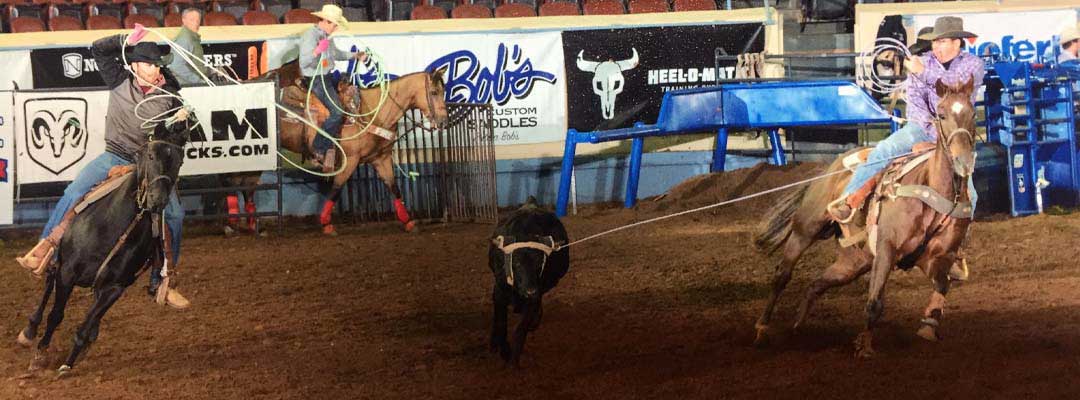Hoof Care Q&A With a Lifelong Horse Farrier
Horse hoof care FAQs, answered

We sat down with longtime horse farrier, John McGuire, located in Oklahoma, to discuss all things hoof care and a few insider tips.
John, you’re a horseman yourself. Tell us more!
I’ve been team roping forever, about 30-plus years. I got lucky last weekend and won four out of five ropings we were entered in and took home four buckles and a .45 pistol.
How many years have you been shoeing and trimming horses?
27 years
Personally, how do you keep up your own horse’s hooves?
I use a hoof conditioner or moisturizer on my horse every day. I’m a firm believer in hoof products like Rain Maker and Hoof Flex and Horseshoer’s Secret. When people say, ‘I have a can of that,’ I say well, you should have an empty can of that. You can’t lie to a horseshoer. We can tell if you’ve been using it. It doesn’t do any good in the can.
Let’s talk about hoof care FAQs. First, how often should horses be trimmed or shod?
A good rule of thumb is to trim or shoe a horse every six to eight weeks. Keep in mind, though, a horse’s hooves can grow at different rates depending on the time of year, and different horses may experience different rates of hoof growth.
When do you know if a horse needs shoes or not?
Well, it depends. Personally, I think if a horse can go barefoot, barefooted is always best. But some horses need shoes on them. For example, I have a good heading horse who always has to have shoes on him. My mare has super-good feet. She’s so tough, she could run across rocks. If she couldn’t take being barefooted, I’d have shoes on her this afternoon. Horse owners also need to consider conditions both at home and when traveling, such as concrete and gravel which can make horses more tender-footed.
Do you have customers that use hoof boots?
I do have a lot of people that travel with them. They will help, especially if horses have extended periods of time standing on hard surfaces like concrete.
Have you shod any horses with glue-on shoes?
I shoe a lot of horses with these, especially barrel horses. If you get the hoof clean and put the shoes on correctly, it’s unbelievable how well they stay on.
Are any of your customers proponents of hoof supplements for horses?
I have several clients who use hoof supplements, and for those horses lacking in certain minerals that promote healthy hooves, you can really see a difference when they’re put on a supplement.
What causes hoof cracks?
To me, there are three main factors that can cause hoof cracks, beginning with the weather. When it’s really dry, a horse’s hooves are more likely to split. The horse’s genetics also plays a role here, and especially important is the overall maintenance of his hooves. If you let your horse go real long, split or break off, his hooves will have a greater potential to crack, especially during dry weather. To me, using hoof conditioners will help prevent hoof cracks more than anything, that along with regular trimming and hoof care maintenance from your farrier every six to eight weeks, based on the horse’s hoof growth and individual needs.
What is thrush?
Thrush is a bacterial infection of the frog of the hoof and surrounding area of the hoof. You’ll notice a black, almost syrupy discharge, and you’ll be able to smell it. You have got to get the hoof dried out, cleaned out and removed of any moisture. I recommend using Thrush Buster. It works well, but like I said earlier, you need to get it out of the can. Horses with thrush can become really sore and tender-footed. If not treated, the condition can be drastic. When it’s wet, especially during the springtime and fall, this can become a real headache for people. I’ve seen a lot of horses with it.
What is white line disease?
Although the technical term is white line disease, I really think of it more like a slight founder. The white line is considered the area between the hoof wall and where it meets the sole. If it becomes damaged, bacteria can cause the layers of the hoof wall to separate. What’s worse is that the infection spreads inside the wall and eats away at the hoof. You have to cut away the affected hoof and hope he stays sound.
What is a common hoof problem you’re seeing lately?
A lot of horses nowadays are thin-walled, and they don’t have enough foot to nail to. When a horse becomes sore, it’s often thought to be the hocks or stifle, but the majority of the time, it goes back to the foot. A lot of horse owners want a little, pretty foot, and I’m just the opposite.
Continue reading with this article on hoof cracks to help ensure your horse’s soundness, and look to trusted equine hoof care products available from ValleyVet.com.
Photo credit: Valerie Ford, cbarcphotography.com


